I regarded today as the first day of my real trek, away from the cities and into the big wide open spaces. I knew it was going to be a busy day. Travelling up the Sunshine Coast involved two ferry crossings. Crossing the Strait of Georgia to Vancouver Island would be yet another crossing. I had spent some time trying to line up the three crossings with enough time to explore between the crossings too. This was not an easy task since the ferries, which are almost as big as cross channel ferries, do not run as frequently. Miss one and I could be stranded. To allow myself the best options I decided to get the first ferry of the day from Horseshoe Bay to Langdale. This meant a 5am start.

Crossing the Howe Sound
|
The trip through the city centre so early in the morning was painless. When I got to the ferry terminal, there were already lines of cars, vans and lorries queued up. I had done my homework, and as a tip for fellow travellers, if you do the complete circular route, starting from Horseshoe Bay, across to Comax on the Vancouver Island and back from Swartz Bay to Tsawwassan, British Columbia Ferries do a deal on a round ticket. This is far cheaper than buying four individual tickets.
The ferry glided gracefully out of Horseshoe Bay across the Howe Sound. The sea was calm, and the snow capped mountains had their lower slopes laced with misty belts. This was truly magical, this is what I wanted to experience. With almost two miles to go before reaching the landing terminal at Langdale, I started to pick up a whiff, not unlike a sewage farm, and it got stronger as we approached land. I asked a fellow passenger what it was, and he confirmed my suspicions, "Pulp has its own peculiar smell".
The Sunshine Coast has provided settlers with abundant natural resources; logging, fishing, farming and the mining of sand, gravel and granite blocks. These have been the principal resource industries on the coast for over 100 years. Many early settlers had three occupations: logging, fishing and farming. They grew their own fruit and vegetables, kept domesticated animals and sold their produce locally and in Vancouver.
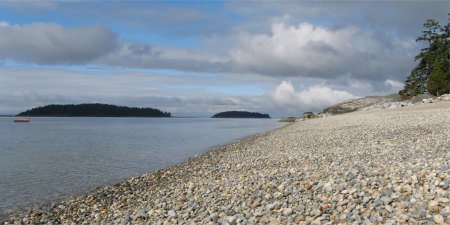
Sechelt Beach
|
|
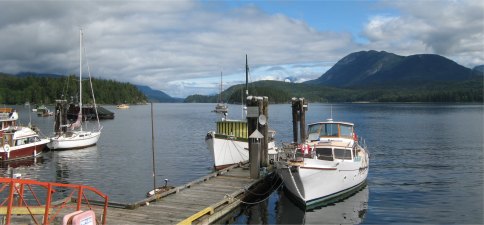
Sechelt Inlet
|
|
Heading up to my next ferry crossing, I stopped off at the small town of Sechelt. I parked in the mall to buy a few more provisions, and when checking out, the Malaysian lady asked me if I had a store card. Similar to my ploy in Seattle, I jokingly replied that I hadn't but she could give me discount if she wanted. "Are you over 55 she asked?". I replied in the affirmative, and without asking for proof, she gave me discount on the non-consumables. It would never work in the UK. Sechelt, labelled as "the land between two waters", has a delightful location. To the west lay a huge expanse of sea lapping gently on the rounded granite pebbles. Walk a mile inland and you come to Sechelt Inlet which lies at the end of Porpoise Bay. Sechelt Inlet has provided salmon, cod and herring and shellfish for local and commercial visiting sports fishermen for many years. Today the inlet supports shrimp and crab collecting, and fish and shellfish farms. About 25 miles up Porpoise Bay, lie the Skookumchuck Narrows which join the bay and the sea. Here strong tides from three inlets rush at speeds up to 15 knots through the spectacular rock strewn passage. I watched a seaplane pass overhead, complete a graceful loop over the inlet before landing like a swan.
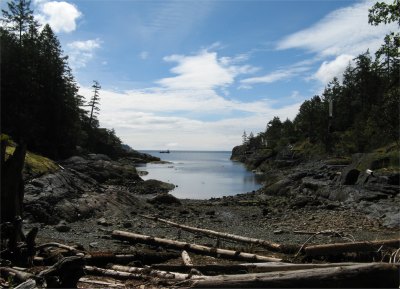
Smuggler Cove
|
I took a detour further up the coast at Half Moon Bay, and headed down into Smuggler Cove area. There I found an idyllic secluded cove. The shoreline consisted of rounded granite outcrops with driftwood cast up in a tangled mass on the tiny shingle shore. On either side of the cove, perched on the granite outcrops, small dwellings existed with narrow paths, wooden walkways and steps to facilitate access. The area was still and totally silent; nobody appeared to be around. Perhaps these were country homes. I had no idea what was in these buildings. The only access was across boulders and rickety walkways, so I imagine they must have been pretty basic. As I departed, a cormorant effortlessly glided in to land on one of the outcrops.
The journey up to Earls Cove skirted the tranquil Ruby Lake which I caught sight of high up through the trees. A long decent brought me down to Earls Cove ferry terminal. The second ferry took me across Agamemnon Channel to Slattery; another beautiful crossing. As the ship weaved its way between islands, it gave a shrill blast from its horn to warn off a fishing boat. The echo resounded five seconds later from distant mountains.
Slattery to Powell River was a shorter drive with no significant features apart from larger hills to contend with. The van handled them well. I soon arrived at Powell River. The region around here contains some of the most spectacular coastal scenery and marine parkland in the world. The town is the commercial centre for the region. The National Historic District, a few miles further up the coast, is the only one in Western Canada. Valued for its architectural and social history, it is still the site of one of the largest paper mills in Canada, and can boast that it produced Western Canada's first roll of newsprint in 1912. Indeed the Historic Townsite is a remarkably preserved example of a single industry company built town from the early 20th century. Built as a garden community with some 400 Westcoast Craftsman style homes, and 30 structures dating between 1910 and 1930, the townsite is an enthralling town of unique heritage. One building in particular, the Patricia Theatre, is the oldest continuously running film theatre in Canada.
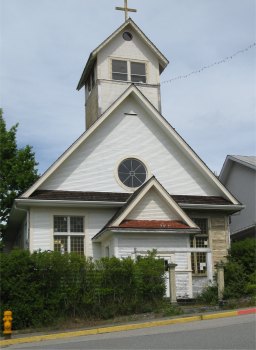
Saint Joseph's Catholic Church
|

Typical Porch in Historic District
|

Historic District Veteran's Memorial
|
|

Patricia Theatre
|
|
The ferry crossing from Powell River to Vancouver Island was like gliding on ice. The subsequent drive down to Qualicum Bay was straight forward after negotiating a route through Courtenay, passing through dense forests with only the occasional "Elk for 25km" sign to break the monotony. Once I reached the Bay, I kept my eyes open for a campsite sign, spotted it and wound my way down to the beach. On arrival I found the campsite office closed. There were a dozen or so RVs parked up by the beach, so I wandered over to ask a couple what the setup was. The said the officials were nowhere to be seen, so people were just laying up, some families had even been here a whole week without any officialdom showing its face. The shower block was closed, but there were a few portaloos scattered around. So I parked up next to the beach, my first camping place of the trip. I thought back to the last time I went camping; I took my two daughters to Sherringham on the North Norfolk coast, roughly 16-17 years ago. There wasn't much light left, so I quickly set up my camping stove and cooked up some eggs, red onions, tomatoes and beans; pretty basic I know but what would you expect camping. I had made a policy, I would eat vegetarian style unless I could buy meats or fish within a few hours of cooking - I had no fridge. A cup of coffee washed it down and I was all done. This process of cooking a meal had led me to reassess my stowing arrangements in the van. I was to learn very quickly what bits and pieces needed storing where in order to make a successful driving/sleeping/cooking environment. No doubt the scheme would be fine tuned as the journey unwound.
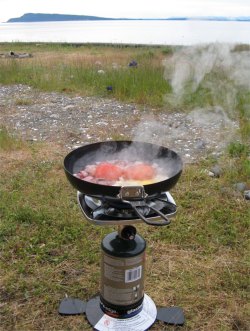
Fry up at Qualicum Bay
|

Sunset at Qualicum Bay
|
To me, this was my first day of the real adventure. The cities were one aspect, but the next three months were going to be pretty much like today. I had thoroughly enjoyed the sunshine coast and associated ferry crossings. And to top it all, the Coast lived up to its name and the sun shone.










